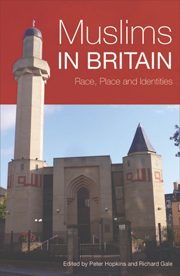Book contents
- Frontmatter
- Contents
- Acknowledgements
- List of contributors
- List of tables
- List of figures
- 1 Introduction: Muslims in Britain – race, place and the spatiality of identities
- Section 1 Gender, place and culture
- Section 2 Landscapes, communities and networks
- 6 British Arab perspectives on religion, politics and ‘the public’
- 7 The multicultural city and the politics of religious architecture: urban planning, mosques and meaning-making in Birmingham
- 8 Holy places, contested spaces: British Pakistani accounts of pilgrimage to Makkah and Madinah
- 9 Excess baggage or precious gems? The migration of cultural commodities
- Section 3 Religion, race and difference
- Afterword
- Index
7 - The multicultural city and the politics of religious architecture: urban planning, mosques and meaning-making in Birmingham
from Section 2 - Landscapes, communities and networks
Published online by Cambridge University Press: 05 August 2013
- Frontmatter
- Contents
- Acknowledgements
- List of contributors
- List of tables
- List of figures
- 1 Introduction: Muslims in Britain – race, place and the spatiality of identities
- Section 1 Gender, place and culture
- Section 2 Landscapes, communities and networks
- 6 British Arab perspectives on religion, politics and ‘the public’
- 7 The multicultural city and the politics of religious architecture: urban planning, mosques and meaning-making in Birmingham
- 8 Holy places, contested spaces: British Pakistani accounts of pilgrimage to Makkah and Madinah
- 9 Excess baggage or precious gems? The migration of cultural commodities
- Section 3 Religion, race and difference
- Afterword
- Index
Summary
Introduction
Mosque buildings constitute an increasingly important feature of British urban landscapes. This is confirmed by the statistics on officially registered places of worship, which indicate that while in 1964 there were only nine officially registered mosques in England and Wales, by 1998 the number had increased to 614 (Peach and Gale 2003). Many of these mosques are in converted buildings, such as houses, factories and warehouses, but others have been purposely constructed, incorporating architectural features that draw upon conceptions of tradition in Islamic architecture. Such designs have often been publicly contested, in terms that construct them as symbols of ‘alien’ cultural presences (see for example Naylor and Ryan 2002). There is now a growing literature documenting contestation over sites of worship, in which the semiotic role played by such buildings in the articulation of opposing social identities constitutes a central theme (see for example, Eade 1993, 1996; Gale and Naylor 2002; Naylor and Ryan 2002). The contribution of this chapter is to explore the place of urban planning procedures in setting the parameters for such contestation, an issue that is receiving increasing academic attention (see for example, Gale 1999; Dunn 2001; Nye 2001; Gale and Naylor 2002; Isin and Siemiatycki 2002). It moves beyond the concern with aesthetic contestation per se to show how urban planning mediates processes of social boundary construction that coalesce around mosque designs, becoming in turn a nexus in which some of the meanings and associations that accrue to such sites are articulated.
- Type
- Chapter
- Information
- Muslims in BritainRace, Place and Identities, pp. 113 - 131Publisher: Edinburgh University PressPrint publication year: 2009



